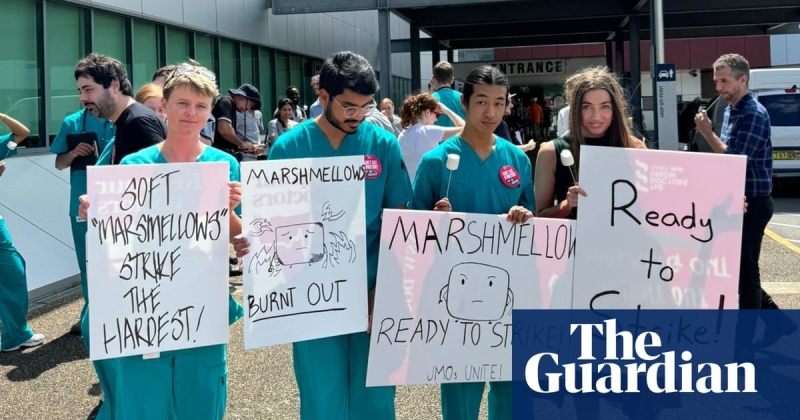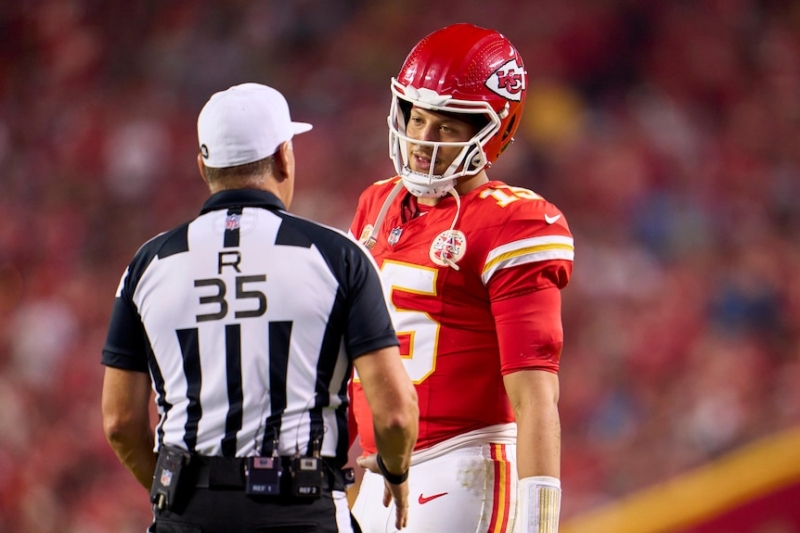Union says viral email stuff-up downplaying junior doctors’ concerns has become a focal point for what it labels ‘toxic’ and ‘hazardous’ workplace conditions
If you were to walk into a New South Wales hospital over the past week, you might have seen doctors bringing marshmallows to work, or perhaps cartoon images of the anthropomorphised gelatinous sweet with a stethoscope and white lab coat upon their break-room walls.
Thousands of doctors across the state have embraced calling themselves “clinical marshmellows [sic]” after a medical administration manager at the Hunter New England local health district called junior doctors the moniker in an email stuff-up.
“People are talking about scrubs with marshmallows on them, or that mimic marshmallows”, Dr Matt Ingram said.
“People have made posters. People are talking about lapel pins. They’re talking about 3D printing little characters to put on their office. People are changing their avatars on Reddit to marshmallows.”
Ingram said doctors are choosing to take the marshmallow image as a “badge of pride” as it has formed a rallying point, drawing attention to the fact the email was “really a microcosm of a much bigger issue”.
The union representing doctors, the Australian Salaried Medical Officers’ Federation (Asmof), said the email was sent in response to junior doctors questioning a decision to roster them on for 10 night shifts in a row.
The message the administrator accidentally sent to the junior doctors stated: “I wonder if any of them realise that they are a doctor and that this is what happens. Oh that’s right … I forgot. Life style [sic] before career. God help us in the future. We are going to have a workforce of clinical marshmellows!”
The Hunter New England local health district quickly apologised for the email, with a spokesperson saying: “We are committed to fostering a workplace where junior medical officers feel valued and respected. The email did not reflect this commitment or our values.”
Kush Wangoo, an emergency medicine trainee, told Guardian Australia he first heard about the email from a friend who worked at the hospital where it was sent. The email then went viral.
“Probably within a day [it] spread across the whole of NSW Health and pretty much every one of my colleagues knew about it,” he said.
The “huge snowballing effect” was because all the doctors reading it identified with the experience of pressure from medical administration to take shifts, or being forced to do unsafe working hours and not being able to push back, Wangoo said.
The Asmof president, Dr Nicholas Spooner, said the email is not an isolated incident at one hospital. “It is a symptom of the broader crisis within our public hospitals that is playing out across NSW,” he said.
Spooner said hospitals are severely understaffed and can’t meet patient demand. “We have a toxic workplace culture that demands doctors risk their own health and safety to fill rosters. And we have workplace conditions that were written 50 years ago.”
Wangoo said upon seeing the email it was “just completely unreal that someone would reflect us in that fashion. Junior medical officers are working some insanely long hours, and at the same time, after working 60 hour weeks, having to study for exams and do an extra 30 hours of study a week to get on to a training program.”
“Then we’re being likened to marshmallows that presumably squash under pressure,” Wangoo said, who pointed out that non-medical staff like administrators don’t have to work overtime or night shifts.
Asmof’s junior vice-president Dr Tom Morrison said “we are finding the humour in what in reality is a pretty catastrophic situation for junior doctors”.
Asmof staged a protest Thursday outside Newcastle’s John Hunter hospital, highlighting that “marshmallow” doctors will be considering strike action after escalating tensions over their “toxic workplace culture and hazardous conditions”.
Dr Alexander Whitfield began his address to the protest: “Marshmallows. Absolutely bizarre reason for a doctor’s union to be talking to the press and talking to the nation.”
Whitfield said being a doctor in NSW means working in “a culture of perpetual scarcity and that scarcity is fuel for burnout”.
“Doctors in NSW are angry and we’re tired, and – I realise the irony given all the marshmallows behind me – but we’re not angry about marshmallows, it’s about all of this stuff – this is just a symbol that has brought us together.”
Ingram, an Asmof councillor as well as emergency department specialist, during the protest called on the premier, Chris Minns, to implement award reform for doctors in the state to address the understaffing, saying, “NSW doctors have the worst conditions and the worst pay of any state in Australia. We can’t recruit nor retain our staff without a competitive award and we want to change that.”
The current award does not afford NSW doctors any protection over safe working hours, which not only affects doctors’ mental health but “most importantly of all” it affects patient care, Ingram said.
The NSW health minister, Ryan Park, said: “We acknowledge that our junior doctors play a vital role in our hospitals and health workforce. I have previously condemned the comments made, and I condemn now.
“We also know that for too long our health system was left understaffed and under-resourced by the former Coalition government. That’s why from the very beginning building an engaged, capable and supported workforce was a top ministerial priority.
“More broadly, we’ve also begun to implement safe staffing levels in our emergency departments.
“We won’t undo the damage left by the previous government overnight – but we are undertaking seismic structural improvements to our health workforce,” Park said.





